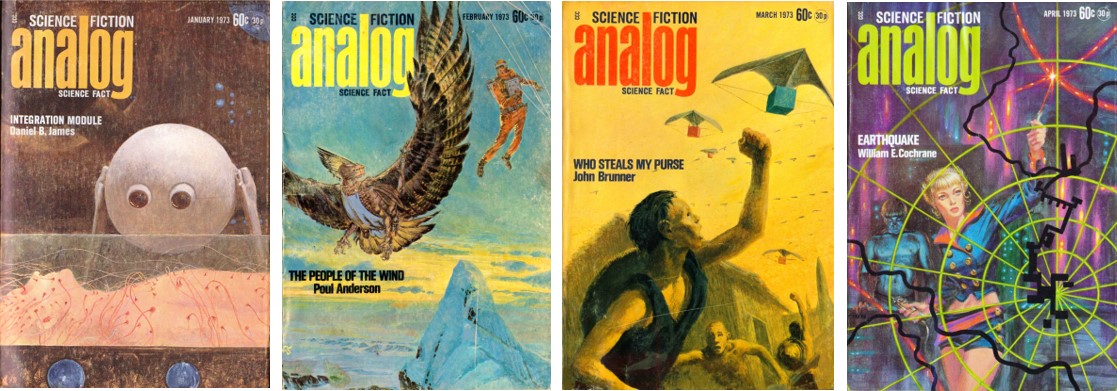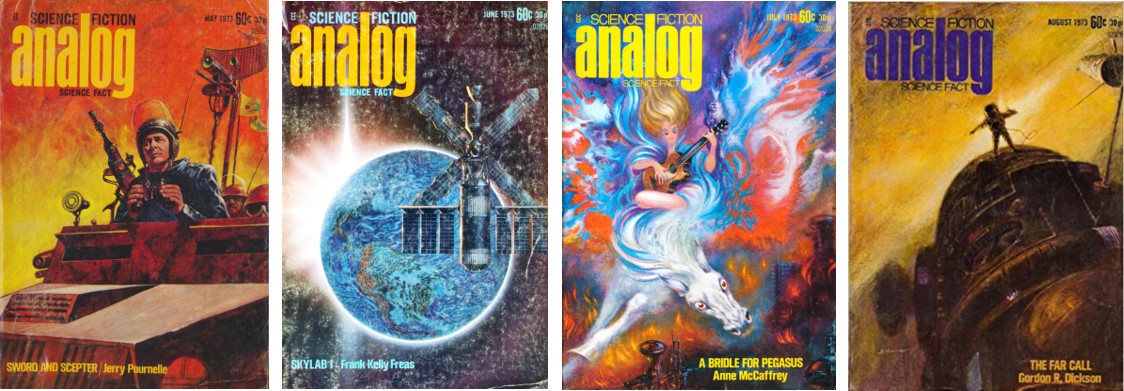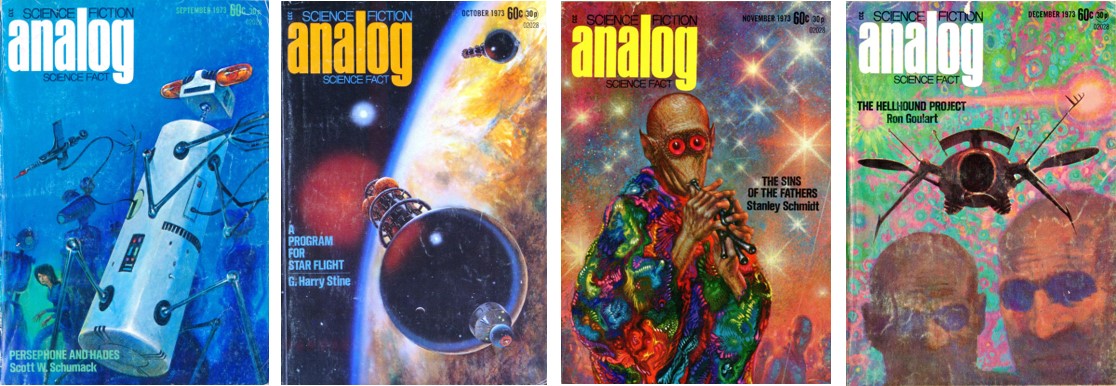



Selective Reading Through Analog Science Fiction & Fact, 1973
This looks like a great year for Analog, from the period in the '70's when Ben Bova was winning the Hugo Award for best editor each year. Around the world, Nixon was sworn in as President for the second time, the Vietnam war was still ongoing, 'Watergate' broke, Sunderland won the FA Cup, and The Exorcist opened in the US on boxing day.

January 1973
Norman Spinrad - A Thing of Beauty
A much anthologised Nebula Award-nominated short story. Spinrad is perhaps most famous for his novel Bug Jack Barron, and was quite a controversial figure in the 70's and 80's. This was an engagingly-written story about a Japanese industrial magnate who visits a post-'insurrection' (i.e. largely devastated) USA to buy an old architectural marvel from US history to add some art and glory to his land back home. While the story wasn't mindblowing, it was a fine example of how good the great old SF authors were at holding a reader and presenting a snappy tale.
February 1973
Spider Robinson - The Guy with the Eyes
This story is notable for being the very first Callahan's Saloon tale and it would become the first story or chapter in the initial Callahan book, Callahan's Crosstime Saloon, published in 1977. Robinson would go on to publish ten Callahan books between 1977 and 2003. In this tale we are introduced to Callahan's Saloon, a drinking establishment for many and varied ethical, friendly and garrulous clients. Set somewhere on Earth (in 'Suffolk country' is all we know), the rule is you pay $1 for any drink, publicly give a toast or oath and then you throw your glass in the fire once you've finished your drink. After an ex-heroin addict throws both his glass and then his heroin in the fire, rejecting the path of self-destruction (much to the approval of the saloon's clientele), a strange and very tall 'man', with unblinking eyes and his shoes on the wrong feet, rises and pronounces an awful doom upon humanity. This was a nice tale - I like Spider Robinson's writing - and it set up future Callahan tales enticingly.
March 1973
Jerry Pournelle - He Fell Into a Dark Hole
Hugo Award nominee for best novelette. This story concerns a starship captain, mourning his lost wife and child who's ship went astray in interstellar space. A renegade scientist thinks she can help find and return several ships that went missing in the same bit of space, and suggests a mysterious black hole caused the spaceships to drop out of hyperspace. Interestingly, black holes are presented as obscure theoretical constructs that navy captains of the future have never heard of. Now, I understand black holes were implied by general relativity, proposed to exist in the manner we understand them in 1958 by Finkelstein, and one was first indirectly observed in 1964 (Cygnus X-1). They got the name 'black holes' in 1967. By 1971, Stephen Hawking had proved they not only exist but evaporate, giving off Hawking radiation. Which makes me wonder why in 1973 Pournelle suggested in his fictional future they were an obscure and forgotten theory. Anyway, the story is quite entertaining, despite being a bit dated - the sexism that was common at the time is on show here (the wife of the protagonist has little input into her choices or future) - but it's well written and well paced. Interestingly, it's set in Pournelle's CoDominium universe, the setting for many of his books, including The Mote in God's Eye co-authored with Larry Niven.
April 1973
Tom Purdom - Moon Rocks
No stories exactly leapt out at me from this issue, but after a bit of research I see that Tom Purdom has published more than the other authors featured in this issue and was later nominated for a Hugo Award for his novelette Fossil Games (Asimov's 1999), so I semi-randomly chose his short story. Purdom's still writing and publishing, incidentally, now aged 84. This story tells the tale of a US military man with a damaged reputation who accepts the difficult job of stealing gold on the moon from the enemy European's lunar territory. He undertakes the task using automated 'gun buggies', alongside his own command vehicle; it's a 'civilised war' that's waged on the moon and no-one is supposed to get killed. It's no classic, but I rather enjoyed the story.

May 1973
George R. R. Martin - With Morning Comes Mistfall
This was Martin's first award-nominated piece of fiction, and helped to launch his reputation and career (it was the Hugo runner-up for best short story in 1974). It is evident that as early as 1973 George R. R. Martin could write well - this is a superior story. An expedition travels to Wraithworld, where great mists rise each evening and fall each morning, to look for evidence of the fabled wraiths of the mists. Not only is it beautifully written, it's about something. Should we try to explain everything we see and hear about, or is there value in the mysteries of the cosmos remaining mysteries?
George Alec Effinger - Naked to the Invisible Eye
A second story from one issue - a break from the plan, surely! But there's method behind the madness in this instance. George Alec Effinger and George Martin became friends and acquaintances around this time, as Martin was breaking through on the SF scene. Indeed, it was in 1973 that both Martin and Effinger were nominated for the John W. Campbell Award for Best New Writer. They lost out to Jerry Pournelle, as they fully expected (and who I featured above from the March 1973 Analog), but they were nonetheless becoming well-established around this time. The arrival of George Martin on the SF convention scene added another George to the mix, and so Gardner Dozois decided Martin would need a nickname. George Zebrowski had already taken 'George', and as a consequence George Effinger was stuck with his childhood nickname 'Piglet'. George R. R. Martin became 'Railroad', on account of his middle initials - a nickname Jack Dann apparently still uses. So, upon seeing that Effinger had a story published in this same issue of Analog, I thought it would be nice to read one story from 'Railroad' and one from 'Piglet'. This story by Effinger is a baseball tale (Effinger loved his sports and wrote many sports-based stories). A young Venezuelan pitcher in the US minor league can influence whether batters swing at a pitch. But if he uses his extra-sensory power all the time, it looks very odd and suspicious. An ambitious coach and catcher work together to make their fortune in the big leagues by schooling the prodigy. Effinger writes very well, and this was a well-paced and enjoyable tale. It's not a classic by any means, and it's rather low on 'science' as fiction, but I enjoyed reading it.
June 1973
J. R. Pierce - The Whimper Effect
This issue contained Notebooks of Lazarus Long, an excerpt from Robert A. Heinlein's 1973 novel, Time Enough for Love, but it's not a story per se, it will already be familiar to many and I recently read the book; so I chose the J. R. Pierce story, instead. John R. Pierce (1910-2002) was more famous as an engineer and scientist than a writer, though he wrote SF from 1930 through to 1973 (this was his last published story). As an engineer at Bell labs and Caltech he won numerous awards including the IEEE Medal of Honor and the Marconi Prize. He became Chief Engineer at the Jet Propulsion Laboratory in 1971. This was an interesting tale, both in plot and structure. The protagonist (a SF writer) visits the Soviet Union to see a fellow writer and at a party there encounters a man who warns him of the gradual dangers of a commonplace technology that could affect people psychologically. The story's title and plot refer to Eliot's famous poem The Hollow Men, which ends This is the way the world ends, Not with a bang but a whimper. The interesting structure I referred to is that the lead character at one point goes to Bell labs (where J. R. Pierce worked for many years) and visits J. J. Coupling - a clever pseudonym Pierce used for some of his earlier fiction. In other words the protagonist visits the author. All in all it's quite erudite and I liked it.
July 1973
Anne McCaffrey - A Bridle for Pegasus
This novella is one of the four stories that comprised McCaffrey's 1973 book, To Ride Pegasus, about a center for psionic 'talents' - the titular pegasus being a symbol for these talents. It takes few pages to get going, but improved as I got more into it. Set in a somewhat dystopian future, where rioting is apparently a perennial problem, the center for psionic talents educates and protects latent psychics to hone their empathy, telepathy, or pre-cog skills - providing a 'bridle' for their 'pegasus'. A young woman musician and psychic of extraordinary abilities is spotted wowing the crowd at one of her concerts, and is recruited to help bring in another uncontrolled latent psychic. This latter character is a social activist and has been trying to use the young woman to foster social unrest. It's quite an interesting idea, but I didn't find it entirely engaging, and I felt it was a touch long and could have been crisper in it's execution.
August 1973
Gordon R. Dickson - The Far Call
This was the first part in a three-part serial, and The Far Call would subsequently be published by Dickson as a novel in 1978. I don't normally select a serial in these explorations, but none of the shorter fiction pieces were noteworthy or eye-catching, so I figured I'd split from tradition on this occasion. I read parts 2 and 3 from the subsequent issues in September and October 1973, but this review is for the complete serial. This novel is great hard SF and if you like reading tales of realistic solar system exploration in the near future, you would enjoy this. The action is split almost 50:50 between scenes on Earth (Kennedy control and the political difficulties behind a manned-voyage to Mars), and the action on board two spaceships who are making the first Mars-bound trip. This story is as much about the way in which political pressures can adversely affect practical outcomes as it is about going to Mars. And yet, there is plenty of action to enjoy too. Due to an over-crowded experimental schedule, agreed to by political committee, the astronauts ('marsnauts') are over-worked and start to make minor mistakes. When disaster strikes, their problems are compounded. The serialised version of this story is I believe only available from Analog, but the expanded 1978 novel (well reviewed upon its publication) may be easier to find. Warmly recommended.

September 1973
George R. R. Martin - Override
This was the first in a short series of stories from Martin known as The Corpse Handlers. This was a neat idea: in the future manual workers can engage corpse crews - dead men with an implanted 'synthbrain' - who they can control with a controller device. It enables them to undertake hard manual labour that cannot be done well by machine (such as, in this story, excavating valuable 'swirlstones' from caves on the world of Grotto). But a local businessman hates the corpse handlers and wants to shut them down. This is a good story - well paced and interesting, with an exciting conclusion.
October 1973
Vonda N. McIntyre - Of Mist, and Grass, and Sand
Nebula award winner and Hugo award runner-up for best novelette. I undertook this with trepidation, as I've struggled with McIntyre in the past, finding her writing style to be dense and uninviting, and the stories not to my taste. This certainly started that way, and I would normally have given up on it, but as I'm trying to explore the good and bad of Analog 1973, and as it won a Nebula award, I stuck with it (somewhat through gritted teeth). A travelling healer 'Snake' arrives in a village from across the desert to heal a small boy using snakes (called Mist, Grass and Sand) with altered 'venom'. It's quite a nice idea, but it's effectively a fantasy tale and feels set in an alternate past, rather than SF. It improved from the start, but it's probably my least favourite story from this year.
November 1973
Sonya Dorman - The Sons of Bingaloo
This issue included the novella We Are Happy Here, by Joe Haldeman, which was very tempting, but it later became one fourth of his award winning novel, The Forever War (which I've read) so I chose this short story by Sonya Dorman. Dorman published over two dozen SF stories between 1961 and 1980 and her story Go, Go, Go, Said the Bird, was part of Ellison's Dangerous Visions anthology. Dorman also published volumes of poetry, and this story concerns poetry also. A man goes to a visiting fair on licensing day to undertake his re-licensing test. In the assessment tent, his brainwaves are computer-scanned for 'quality' during his creation of a poem. It's short, but nicely done, and a novel idea. Interestingly, this is not the sort of story Analog would probably publish (or receive) these days - it was more catholic in its contents in the 1970's I think.
December 1973
Ron Goulart - The Hellhound Project
This was a pretty good novella. Ron Goulart is not an author I'm very familiar with, but he's prolific, having written many novels and over a hundred short fiction stories since 1952. He's also an historian, and expert on comic books. This story, set in a dystopian, post-viral America, concerns the infiltration of a wealthy industrial family by a lookalike of the family patriarch, Robert Walbrook I. The original Walbrook was put into suspended animation in 1979 due to sickness, and fifty years later our protagonist pretends to be the newly awoken Walbrook, in an effort to learn about the family's mysterious Hellhound Project. It's clearly and engagingly written, tense and well-paced.
Overall Conclusions
This was an excellent year for Analog, I think, and it seems little surprise that Ben Bova won the Hugo for Best Editor. Highlights were the Gordon R. Dickson serial novel and the George R. R. Martin stories, but special mention should be given to the Spider Robinson, the J. R. Pierce story and the Ron Goulart novella.